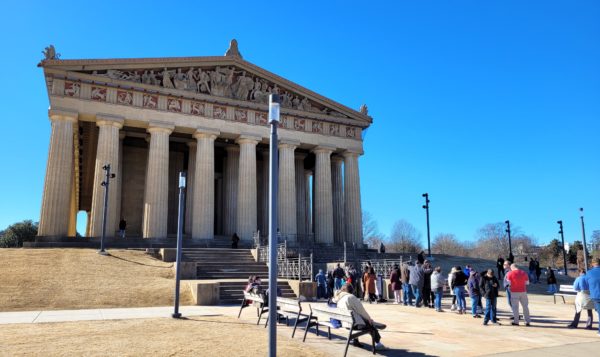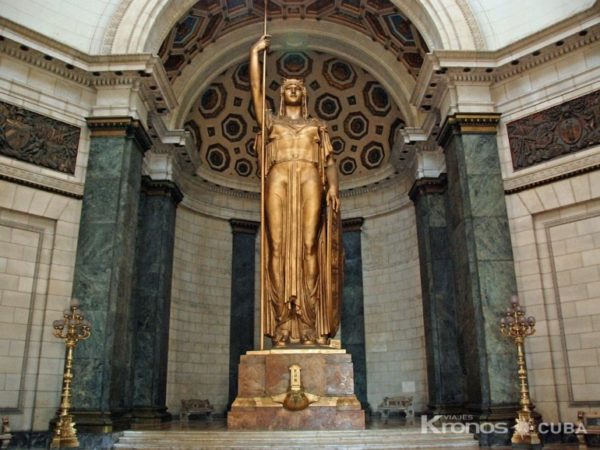From Nashville to Havana, a Tale of Two Statues

By Vicente Morin Aguado
HAVANA TIMES – The January sun in Tennessee illuminates but doesn’t give any warmth, a difference that still surprises yours truly, who was born under the Tropic of Cancer. Forecasting a beautiful day with temperatures of 1-3 degrees Celsius in Havana would get sneers for the daring weatherman. Although here you just need to wrap up properly and you can drive to Centennial Park, in the outskirts of Nashville, without any problems. There, an Athenian Parthenon towers in the landscape, near Appalachia.
In the flatland that leads up to the great US mountain range in the West, a building that symbolizes harmony, order and democratic governability has been replicated to its original size, just like it must have looked 2500 years ago, when Athenians planted the ideal of freedom as a human right to discuss and individually vote for the proposals they believe are the best for the community.
The greatest gift lies in the enclosure’s main room, the statue of Athena Parthenos (The Virgin), goddess of wisdom, war and handicrafts, who was the patron of proud Athens during Phidias’ lifetime, the young man who was touched by the Gods and sculpted the original statue, which was completed in 439 B.C.
The new Parthenon was initially built out of wood, plaster and brick, and was inaugurated in 1897, when Tennessee was celebrating its centennial as a State in the Union. The building was remodeled in sandstone in the Greek Mediterranean style that you can see today and was completed on May 31, 1930.

Back then, Tennessee residents couldn’t admire the imposing statue of the goddess like they can now, in white and gold, described as chryselephantine, due to the principal use of ivory and gold.
A paradox of the rich poor man, dictator Gerardo Machado inaugurated the Capitolio building in Havana, just a year before on May 20, 1929, which was as big as the one in Washington. Not falling short on the fixation of any autocrat, a Statue of the Republic was placed inside, inspired by and a copy of the millennial Hellenic figure.
The first American Athena was made by Italian Angelo Zanelli, in bronze, and a controversy surrounds its dimensions: Measuring 11.5 meters from the woman’s head to her feet, reaching 14.6 m because the figure has an arm raised and is holding a long spear in a vertical position. If you add the pedestal, the Cuban ensemble finally measures 17.1 m tall. Different media outlets, especially in Cuba, have called it the third tallest sculpture in a building, only surpassed by the golden Buddha in Japan’s Tōdai-ji temple and the statue of a sitting Lincoln, at his memorial in Washington.

The top spot is clearly taken by the Japanese Buddha at his temple, while the statue of the US president who signed the historic Emancipation Proclamation to free slaves, measures 18 m as a whole ensemble, but the human part only measures 5.8 m. Experts explain that if he were to stand up, Lincoln would measure 8.5 m.
Saying that a sculpture is the tallest, in a building, poses the following question: is it just the sculpted figure or the ensemble with its pedestal and other adornments?
The Havana statue represents a woman wearing classic Greek attire, copied from the millennial Athena Parthenos statue in shape and style, although the original was lost, but there were many copies, as well as a descriptive account by historian Pausanias, who admired her personally. There are other copies, even on old coins.
Going carefully through all the information available, Alan LeQuire, a Nashville local who graduated from the local Vanderbilt University, created his masterpiece, a replica of the watchful Goddess, down to the smallest detail and with the similar sternness of the Eclessia assemblies. These citizens’ assemblies took place in the agora next to the Parthenon, where Athenians took the concept of City/State, the polis, and gave it a cultural status, and by the extension of the word polis, that citizens exercised politics.
The new Athena copies the whiteness of ivory – although the quantity of ivory needed isn’t available today -, there is gold, of course, a thin layer which is 1/3 of tissue paper in thickness, we’re told. Nevertheless, almost 4 kg of 24 K gold was needed to finish the statue, which could even be sore on the eyes today because it’s so flashy.
By the way, during Phidias’ time, approximately 1100 kilos of this golden metal was used, a part of the treasury belonging to the Athenians empire built on the Aegean Sea.
Digging into this controvery, many articles published in the US, including others found on online, Wikipedia too, say that:
“The Athena Parthenos in Nashville measures 41 feet and 10 inches (12.75 m) tall, which makes it the largest sculpture inside a building in the Western World, which is fitting for this great goddess from the Greek capital.” (Patricia Claus, specialized reporter).
These are head to toe measurements, as no other sculpture beats the original statue of the goddess, and the talented LeQuire copied it exactly, who also made other monuments, as well as a gallery that shares his name and can be visited in the capital of Country music, which this famous artist is also a fan of.
This statue was unveiled inside the Parthenon in Nashville, on May 20, 1990, exactly 61 years after its tropical predecessor. The Havana statue, originally a bronze, was also plated in a fine layer of gold in 2017, using Russian gold and the experience of its maestros, who trained in the golden domes of their Orthodox churches.
Ruling out the Lincoln memorial if we’re only taking about the human statue’s height, we’re left with the two Athenas: the Cuban one and the Tennessee one. Which is taller, given the above measurements?
If we’re speaking strictly about the sculptural ensemble, the answer is Cuba’s, but if we are talking about the human figure from head to toe, then it’s the Nashville statue.
After seeing the virgin goddess in both its representations in the New World, I call upon her powers to reach her first home, the birthplace of civility, which we Cubans so desperately need today.





